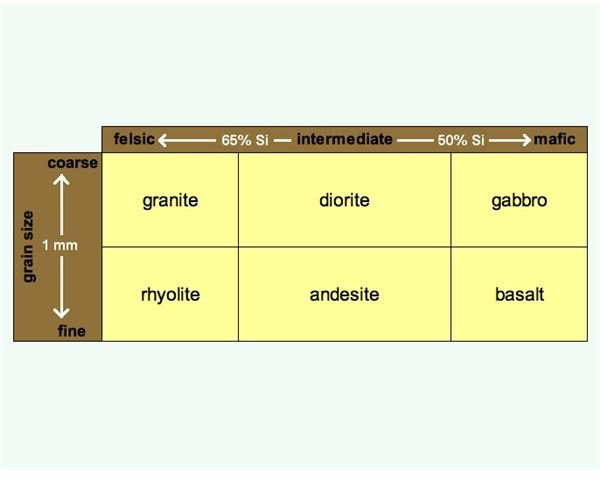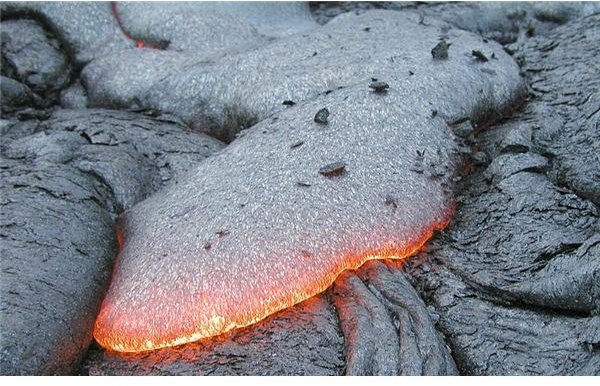Two Types of Igneous Rocks: The Differences Between Granite and Basalt
Igneous Rocks
Igneous rocks are rocks that have formed out of magma (molten rock). The two types of igneous rocks most common on Earth are called granite and basalt. Granite is a rock that typically looks pink and white with black specks. Basalt generally just looks black.
Igneous Rock Types by Chemical Composition
Granite and basalt are at opposite ends of a chemical composition range defined by percentage of silicon. Rocks composed of over 65% silicon are called felsic, which is short for “has lots of feldspar” (feldspar is a type of mineral). Rocks with less than 50% silicon are called mafic, or “magnesium-ferric” (ferric means iron), and less than 45% silicon are ultramafic. Rocks between 50% and 65% are just called “intermediate.”
The amount of sillicon plays a major role in determining which minerals the rock has. Mafic minerals have proportionally the least silicon, while felsic minerals have the most. Mafic and felsic are also at opposite ends of a range of melting/freezing temperatures. Mafic minerals have the highest melting/freezing points, while felsic minerals have the lowest. In a cooling body of magma, the most mafic minerals crystallize first and the most felsic ones last, in an order known as Bowen’s reaction series.
Roughly in order from mafic to felsic, the most common minerals are: olivine, pyroxenes such as augite, calcium-rich feldspar (plagioclase), amphiboles such as hornblende, the mica biotite, sodium-rich feldspar (also plagioclase), potassium-rich feldspar (orthoclase), the mica muscovite, and quartz.
To summarize, the two types of igneous rocks by chemical composition are felsic and mafic. Granite - typically composed of orthoclase, hornblende, biotite, and quartz - is a felsic rock type. Basalt is mostly olivine, augite, and calcium-rich plagioclase, therefore mafic.
Igneous Rock Types By Grain Size
Igneous rocks can also be classified according to the average size of their individual mineral grains. A grain size of one millimeter or more is considered coarse-grained, and the minerals are easy to see and identify. Less than one millimeter is fine-grained. Usually you need some form of magnification, such as a hand lens or microscope, to identify the minerals in a fine-grained rock. Granite is a coarse-grained rock, while basalt is fine-grained.
Grain size comes from how slowly the body of magma (or lava) cooled and solidified. A slower cooling time means minerals have more time to form larger crystals. Igneous rocks with no grains at all are called obsidian. These cooled so fast that nothing had time to crystallize. Obsidian is technically glass rather than rock.
The Six Types of Igneous Rocks

To recap, granite is a coarse-grained felsic rock, while basalt is a fine-grained mafic rock. All of the other combinations have names too. A coarse-grained mafic rock is called gabbro, and a fine-grained felsic rock is called rhyolite. There are also names for the intermediates: diorite if it’s coarse-grained, andesite if it’s fine-grained.
So there are actually six types of igneous rocks. (Seven if you also count ultramafic, which is always coarse-grained and almost always entirely olivine and pyroxenes with no feldspars.) Some geologists subdivide these even farther, but the six official arbitrary categories are granite, diorite, gabbro, rhyolite, andesite, and basalt.
Igneous Rock Types by Formation

Igneous rocks can also be classified as intrusive or extrusive. Intrusive rocks come from a body of magma that cooled and solidified deep underground, generally over millions of years. Intrusive rocks are usually coarse-grained; minerals have plenty of time to grow when cooling is slow. Once completely solidified, the entire body of rock is called a pluton or batholith (basically a very large pluton). Most plutons are made of granite.
Extrusive rocks come from volcanoes. Magma that reaches the Earth’s surface - called lava - is suddenly exposed to much lower temperatures and pressures than deep underground. Because lava cools and solidifies rapidly, extrusive rocks are usually fine-grained. Basalt is the most common type of extrusive rock.
Extrusive rocks can also be porphyritic, which means they have coarse-grained minerals embedded in a fine-grained matrix. Since different minerals have different melting/freezing points, some can start crystallizing before others and get a head start on growth.
References and Photo Credits
Plummer, Charles C. and McGeary, David. Physical Geology 5th ed. 1991.
Dana, James D. Manual of Mineralogy 20th ed. Revised by Cornelis Klein and Cornelius S. Hurlbut Jr. 1985.
Granite image by Friman, used under CC-A-SA 3.0 Unported license
Basalt image by U.S. Geological Survey, public domain
Rock types diagram by article author
This post is part of the series: The Basics About Igneous Rocks and Minerals
Learn how igneous rocks are classified, and how they form from magma, in this series of articles.
